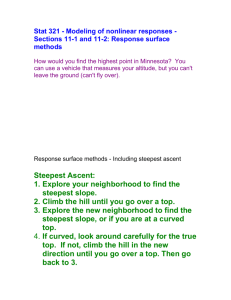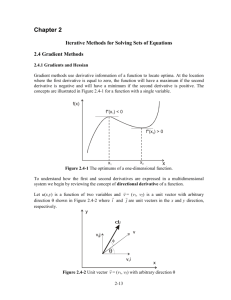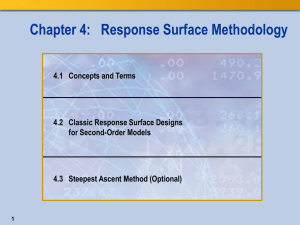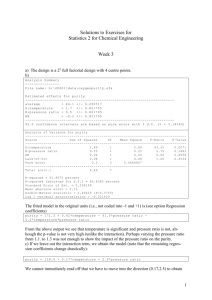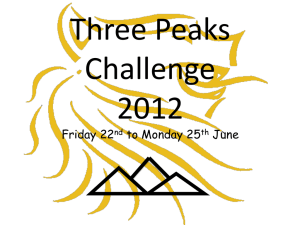Centerpoint Designs
advertisement
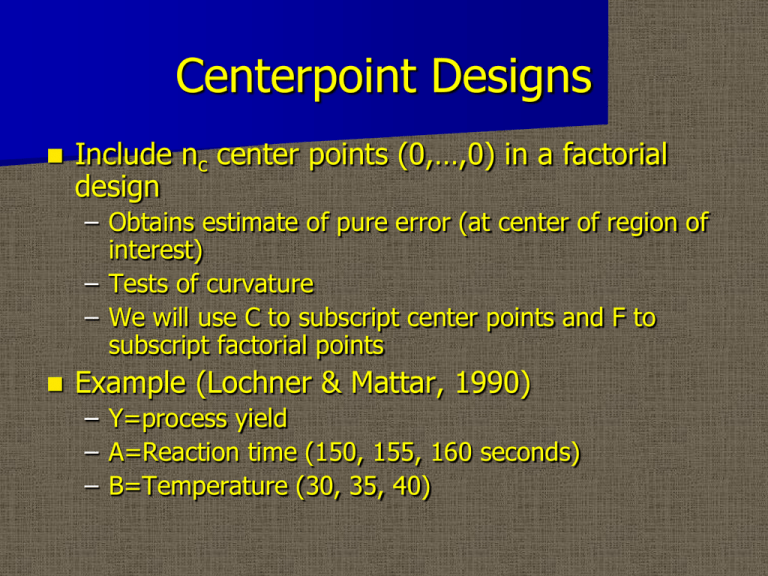
Centerpoint Designs Include nc center points (0,…,0) in a factorial design – Obtains estimate of pure error (at center of region of interest) – Tests of curvature – We will use C to subscript center points and F to subscript factorial points Example (Lochner & Mattar, 1990) – Y=process yield – A=Reaction time (150, 155, 160 seconds) – B=Temperature (30, 35, 40) Centerpoint Designs +1 B 41.5 40 40.3 40.5 40.7 40.2 40.6 0 -1 39.3 -1 40.9 0 A +1 Centerpoint Designs Statistics used for test of curvature yC (40.3 40.5 40.7 40.2 40.6) / 5 40.46 yF (39.3 40.9 40 41.5) / 4 40.425 sC .20736 Centerpoint Designs When do we have curvature? For a main effects or interaction model, yc yF Otherwise, for many types of curvature, yc yF Centerpoint Designs •A test statistic for curvature yC yF T 1 1 sC nC nF Centerpoint Designs T has a t distribution with nC-1 df (t.975,4=2.776) T>0 indicates a hilltop or ridge T<0 indicates a valley 40.46 40.425 .035 T .25 1 1 .139 .20736 5 4 Centerpoint Designs We can use sC to construct t tests (with nC-1 df ) for the factor effects as well E.g., To test H0: effect A = 0 the test statistic would be: T A sC 2 k 2 Follow-up Designs If curvature is significant, and indicates that the design is centered (or near) an optimum response, we can augment the design to learn more about the shape of the response surface Response Surface Design and Methods Follow-up Designs If curvature is not significant, or indicates that the design is not near an optimum response, we can search for the optimum response Steepest Ascent (if maximizing the response is the goal) is a straightforward approach to optimizing the response Steepest Ascent The steepest ascent direction is derived from the additive model for an experiment expressed in either coded or uncoded units. Helicopter II Example (Minitab Project) – Rotor Length (7 cm, 12 cm) – Rotor Width (3 cm, 5 cm) – 5 centerpoints (9.5 cm, 4 cm) Steepest Ascent Helicopter II Example: RL * 9.5 RL RL* 9.5 2.5 RL 2 .5 RW * 4 RW RW * 4 RW 1 Steepest Ascent The coefficients from either the coded or uncoded additive model define the steepest ascent vector (b1 b2)’. Helicopter II Example 2.775+.425RL-.175RW= 2.775+.425(RL*-9.5)/2.5-.175(RW*-3)= (2.775-1.615+.525) + .17RL* -.175RW*= 1.685+.17RL*-.175RW* Contour Plot of Flight Time (Seconds) vs Rotor Width, Rotor Length 5.0 2.8 2.4 RotorWidth 4.5 4.0 3.2 3.5 2.6 3.0 7 3.0 8 9 10 RotorLength 11 12 Steepest Ascent With a steepest ascent direction in hand, we select design points, starting from the centerpoint along this path and continue until the response stops improving. If the first step results in poorer performance, then it may be necessary to backtrack For the helicopter example, let’s use (1, -1)’ as an ascent vector. Steepest Ascent Helicopter II Example: Run RW* RL* 1 3 12 2 2.5 12.5 3 2 13 4 1.5 13.5 5 1 14 Steepest Ascent The point along the steepest ascent direction with highest mean response will serve as the centerpoint of the new design Choose new factor levels (guidelines here are vague) Confirm that yC yF Add axial points to the design to fully characterize the shape of the response surface and predict the maximum. Central Composite Design 1.5 Block s 1 2 1.0 X2 0.5 (0,0) includes 3 Block 1 runs and 3 Block 2 runs 0.0 -0.5 -1.0 -1.5 -1.5 -1.0 -0.5 0.0 X1 0.5 1.0 1.5 Steepest Ascent The axial points are chosen so that the response at each combination of factor levels is estimated with approximately the same precision. With 9 distinct design points, we can comfortably estimate a full quadratic response surface E(Y | X ) b0 b1x1 b2 x2 b11 x12 b22 x22 b12 x1x2 We usually translate and rotate X1 and X2 to characterize the response surface (canonical analysis)
